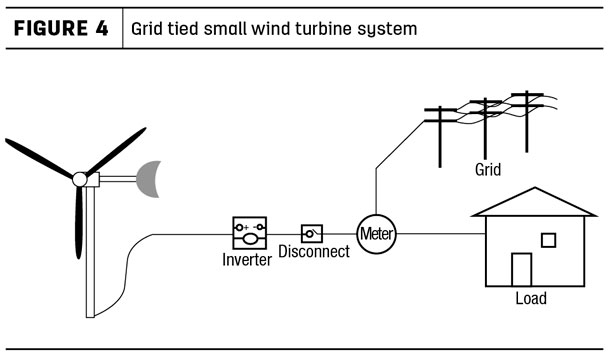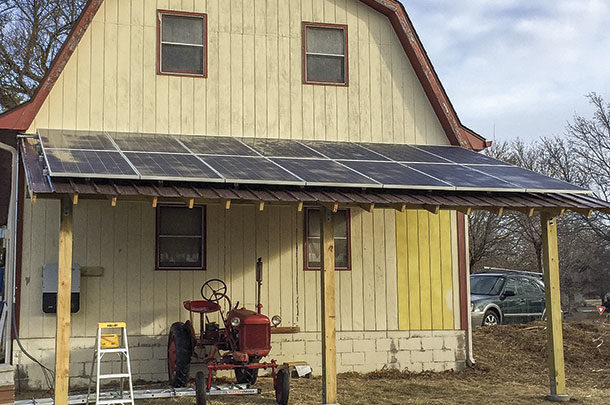Some want to be part of the clean “green” energy movement. Others desire the independence renewable energy can provide. An examination of your goals is a critical part of choosing whether or not to invest in a renewable energy system.
For example, a rancher with a goal of clean energy may be less concerned with the financial returns than a rancher who mainly has an investment-related goal. When considering any renewable energy system, take the time to talk through your goals with your family, business partners, etc.
Small wind turbines make up a range of turbine sizes from a few hundred watts to 100 kilowatts. Systems larger than this are generally considered utility-scale wind turbines and will not be discussed in this article.

Small wind turbines come in a variety of shapes, sizes, tower types and tower heights, yet there are some universal truths when it comes to their potential to produce energy. The laws of physics dictate these truths – and any salesman who tries to explain their turbines has overcome these is simply wrong.
Wind turbines obey the laws of physics:
-
Rule No. 1: No wind or slow wind = no power or almost no power
-
Rule No. 2: Small turbines = small amount of power
-
Rule No. 3: Kinetic energy in wind is converted to rotational energy and is always less than 59.3 percent efficient no matter how innovative the design. (This efficiency is called the Betz limit, named after a German physicist who did the calculation in about 1920.)
-
Rule No. 4: Spinning is cool, but spinning makes vibrations
- Rule No. 5: Turbines on buildings = almost no power (because of rules No. 1, No. 2, No. 4)
Big and windy
The power in the wind is related to the swept area of a wind turbine; thus, to generate enough energy annually to run an average U.S. home, it would take a turbine with a 12- to 16-foot diameter. The power in the wind is cubically related to the wind speed.
For example, there is a major power difference between a 16-foot-diameter wind turbine in a location with an average wind speed of 4 mph versus a location with an average wind speed of 12 mph. Power at the location with a 4 mph average speed is 53 watts versus power at the 12 mph location, which is 1,441 watts. If efficiency is 30 percent, you would have a turbine output of 16 watts and 432 watts, respectively.
To ensure a windy location, make sure the turbine is up high (at least 30 feet above anything within 500 feet) and in a rural environment. (Urban environments cause turbulent air flow which slows wind speeds.)
Design
There are three major wind turbine designs.
-
Savonius: These machines are predominantly vertical axis, rely on drag forces and have low rotation speed (Figure 1).
 Picture a 55-gallon drum cut in half and then pulled halfway apart and welded to a vertical pipe.
Picture a 55-gallon drum cut in half and then pulled halfway apart and welded to a vertical pipe.
-
Darrieus: These machines are predominantly vertical axis and have airfoil blades, which use mostly lift forces; blades with lift forces can spin many times faster than the wind blows. Some look like an eggbeater or the mixer attachment placed vertically (Figure 2).

- Horizontal axis: These machines have airfoil blades that use mostly lift forces; these turbines blades can spin six to seven times faster than the wind blows. These are generally what we think of when we think of wind turbines, with two or three blades (Figure 3).

Designs such as Savonius spin slowly and are inherently low-efficiency and thus will underperform against Darrieus and horizontal axis machines. The Darrieus machines have potential but have not had much success, as many past designs were not robust enough or were placed too low to the ground and thus did not have good performance.
Designs with airfoils like the Darrieus and horizontal axis machines have higher tip-speed ratios (tip speed divided by wind speed). When a turbine has slow tip-speed ratio, it wastes power spinning the air behind the turbine. High-tip-speed ratio machines have less wake rotation and thus have higher efficiency.
In my opinion, the number one design criteria should be robustness, or a turbine’s ability to survive in the harsh windy environment, followed by efficiency. It makes no difference if a wind turbine is efficient if it breaks down during a storm.
How to choose a wind turbine
The proof is in the production; a wind turbine must have proven ability to produce electricity. You would not likely buy a car from an unknown car manufacturer; you should not buy a turbine from an unknown turbine manufacturer. Ask and seek data to show a turbine design has proven its ability to survive in a windy environment and produce energy.
Without either of these, do not go any further. One good place to check is the Small Wind Certification Council.
Horizontal axis designs are the clear winner, with nearly zero of the other designs available from companies with any long-term status. You will likely find many turbine brands available but few with the reputation for reliability and proof of production; choose one with both.
Installation
Select an installer the same way you chose the turbine. Choose one who has experience and will hopefully be around a while to offer you follow-up service and maintenance.
The bad news – economics
Small wind turbine prices have remained fairly high compared to the rapid decline in solar panel prices. It is hard to put a price on small wind turbines without knowing details such as turbine model, tower type, tower height, etc. Yet it is easy to say they are expensive, with very small ones in the $500 to $1,000 range to 10-kilowatt machines costing upward of $75,000 and 100-kilowatt machines in the quarter- to half-million-dollar range.
The economics of small wind turbines depend on three main factors of production, price of electricity and incentives. For best financial results, a wind turbine must produce electricity – to do so, it must be an appropriate design, be put in a windy location and not break down.
Additionally, a higher price received for the electricity generated will improve the economic viability of the turbine. Incentives improve the economics, either by offsetting initial cost or increasing the value of the electricity. Unfortunately, the federal tax credit of 30 percent of the total system costs has been allowed to expire, leaving only state and utility incentives.
My conclusions
1. Small wind turbines are cool.
2. Small wind turbine economics are challenging, especially due to expiration of the federal tax credit at the end of 2016. (Note: The 30 percent credit was renewed for solar PV [photovoltaic] only and is available until 2019. The economics are ever-changing; be careful to compare apple to apples when getting quotes and always double-check the production estimates, as they can easily be inflated.)
3. If you are in the market for a small wind turbine, do your homework and choose a turbine and installer with a proven track record for success.
4. Turbines must be big, high off the ground and have a design with airfoils to have any chance for success.
5. Wind turbines require maintenance. Plan ahead to spend money on maintenance. Also, because turbines have moving parts, they will likely break down eventually and need fixed. This is the main reason to choose a robust turbine and an installer who will be around to help.
I have installed two turbines at a university research farm; both have broken down and required maintenance in the first five years, and I tried to follow my own suggestions regarding turbine and installer selection (read more about this project at Sustainable energy options).
6. Never put a turbine on a building.
7. Consider solar. (Note: My 4.48-kilowatt solar array at my home provides about 60 percent of my annual electricity.)
More on economics
There are multiple ways to calculate economics of renewable systems including payback, rate of return and net present value. To keep this simple, let’s start with simple payback, as it can tell us if a system is even worth considering.
Simple payback = Total installation costs / (Production in kilowatt hours per year x average value of electricity)
Example: $50,000 / (13,000 kilowatt hours per year x $0.10 per kWh) = 38 years
If a system will last approximately 15 to 20 years, a payback of 38 years is not likely going to ever pay for itself, even if the price of electricity increases over time.
Incentives
Grants, tax credits, rebates and other forms of incentives exist for renewables. Since these are ever-changing, and depend on your location and utility, I will simply send you to a website where you can find them for yourselves. Visit www.dsireusa.org and select your state to find incentives. Incentives exist at many levels, including local, utility, state and federal.
I will mention two important federal subsidies. The federal tax credit equal to 30 percent of the total cost of a small wind system expired at the end of 2016. If installed or paid for prior to the end of 2016, you could receive the federal credit. Applying the credit to our example above would reduce the cost of the system by $15,000 and reduce simple payback to 26 years.
An additional subsidy available to rural businesses and farms is the Rural Energy for America Program (REAP) grant. This grant is worth up to 25 percent of the project costs and would take our payback in this example down to 20 years.
It is clear: Without subsidies, the economics of small wind turbines is challenging at best. The example above is fictional but does resemble system economics I have seen recently.
Although I do want to impress upon you the poor economic returns which are possible for small wind turbines, I also want to provide examples which are more positive.
A better choice
Solar photovoltaic (solar electric or PV) systems have reduced in cost by more than half in the past few years, and this dramatic price reduction has in turn driven down the payback periods. Solar installations are increasing due to the economics, long life and low maintenance of solar PV systems.
A payback of five to 14 years is common for solar. Areas with higher electricity costs and better incentives are on the lower end, while areas with fewer incentives and lower electricity costs are on the high side. Even at 14 years, the solar array should last 25 to 30 years, with the panels themselves warrantied to 25 years.
When small wind can work
Distributed generation systems can be either grid-connected (Figure 4); grid-connected with battery backup or off-grid.

In the case of an off-grid system with a solar array, the designer must consider long stretches of cloudy days. In this case, a combination of wind and solar, with the wind providing most during the windy months of winter and the solar providing most during the sunny days of June to August. ![]()
PHOTO 1: Solar panels are installed in a residential application in Nebraska.
PHOTO 2: Small wind turbines come in a variety of shapes, sizes, tower types and tower heights, yet there are some universal truths when it comes to their potential to produce energy. The laws of physics dictate these truths – and any salesman who tries to explain their turbines has overcome these is simply wrong. Photos provided by John Hay.
F. John Hay is the extension educator – energy at the University of Nebraska – Lincoln. Email F. John Hay.










